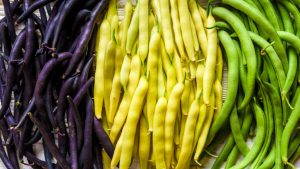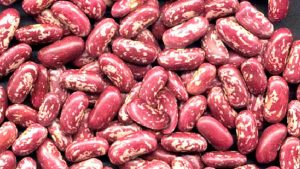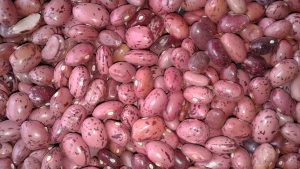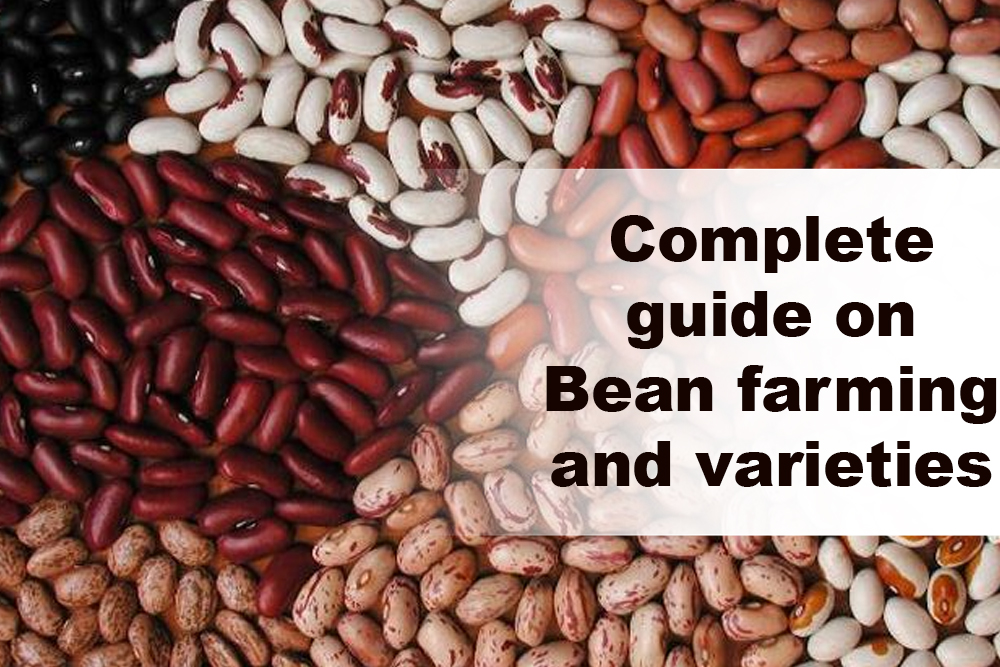The demand for beans has grown in recent years due to the high cost of living putting pressure
on bean farmers to increase their production. In other words it is very affordable to all and
sundry under the prevailing economic circumstances. It is one of the staple foods meaning it is
eaten regularly or daily in most homes. Beans also provide energy and nutritional needs to the
masses.
This has contributed to the high demand for beans hence the shortage of the same in the market.
Its production is lower compared to consumption locally with the deficit imported from
neighboring countries. However, it is encouraging to note that bean production cost is low.
Therefore, high yields can be achieved if certified and disease resistant seeds are used. In
addition, farm inputs and good farm practices should also be incorporated.
Young bean crop growing healthy
Importance of Beans
Beans are a source of energy, proteins, vitamin A and B complex, micro nutrients including Iron
and Zinc. Bean crop also adds nitrogen to the soil. Kenya is a major producer of beans in the
region and the world with over 1.4 million small scale farmers spread all over the country. This
is in spite of beans being grown as an inter crop, a practice that needs to change. Therefore,
farmers are advised to adopt to pure stand planting of beans for nutritional and financial worth.
Consequently this will enable the country realize nutrition, food security and poverty reduction.
Bean varieties

Bean varieties vary in yields, shape, size, color, taste, maturity rate, tolerance and resistance to
drought and diseases, shelf life etc. Others are either bush or climbing cultivars. Subsequently,
this gives farmers a wide range of bean varieties to choose from. With their availability in the
market and use, yields are likely to increase. Additionally, farmers need to embrace new varieties
like Nyota and Angaza, which are high in Iron and Chelalang, Ciankui and Tasha, which are
high yielding beans bred by KALRO and Egerton University respectively. Other varieties
available in the market include Rosecoco, Mwezi Moja, Mwitemania, Yellow beans, Katumani,
Kenya Mali, etc.
Rosecoco Bean Variety

The seed is red in color with cream flecks. It prefers an altitude of between 1500-2000m with
medium or high rainfall. Rosecoco is very adaptable and is resistant to anthracnose and CBMV.
However, the bean variety is susceptible to rust and ALS. It matures in 3 months and the rose coco beans yields per acre is approximately 1.8-2.0ton/ha. Rosecoco can be purchased from outlets including COPIA KENYA, Simlaw Seeds, Kenya Seed Company Ltd, Dalima Foods.
Mwezi Moja, Bean Variety
The GLPX1127 does well in altitude of between 1000-1500m. It is adaptable and tolerant and
resistant to rust and CBMV respectively. It reaches maturity in 2.5-3.0 months and Mwezi Moja bean variety beans yields per acre is approximately 1.0-1.5ton/ha. Mwezi Moja can be purchased from Kenya Seed Company Ltd, Simlaw Seeds,
Mwezi Moja (GLP 1004)
This variety is recommended for semi-arid and areas with low and medium rainfall. It is beige in
color and is tolerant to drought and bean fly though susceptible to HB. At altitude of 1000-
1600m the Mwezi Moja (GLP 1004) variety yields 1.2-1.5ton/ha. The bean variety matures in 2-3 months. Mwezi Moja (GLP 1004)
can be purchased from Kenya Seed Company Ltd.
Mwitemania, Bean Variety
An altitude of 900-1600 is ideal for the variety to produce 1.2-1.5ton/ha in 2-3 months. It can do
well in a wide range of areas with low to high rainfall. It is tolerant to drought but susceptible to
CBMV. Mwitemania can be purchased from Simlaw Seeds.
Yellow beans, Variety

This variety is adaptable hence it can be grown in a number of areas. It Yellow Beans yields 500kgs-900kgs per acre. It matures in 2-2.5 (months). Yellow bean can be purchased from Dryland Seed Ltd
Chelalang Bean Variety

It can grow in a number of areas at medium to high altitude (1800m) and yields 600kgs per acre.
It takes 2.5 (months) to mature and is resistant to drought. Chelalang can be purchased from
Simlaw Seeds, East African Seed Co. Ltd, Faida Seeds.
Nyota Bean Variety
The bean variety matures in 60-70 days and the Nyota Bean Variety yields 1.4-2.0ton/ha or. It is tolerant to drought. It prefers altitude of 1000-1600m, areas with low or medium rainfall of 750-1000mm per annum. It has good cooking qualities (cooks fast). It tolerant to drought. Nyota can be purchased from KALRO, Kenya Seed Company Ltd.
Angaza (KMR 11) Bean Variety
The bean variety prefers altitude of 1200-1900m. Angaza bean variety is tolerant to Common
Bacterial Blight (CBB), rust Bean Common Mosaic Virus (CBMV) and Angular Leaf Spot
(ALS). It has good cooking qualities (sweet, cooks fast and soaks well). The bean variety yields
6-12 bags per acre and matures in 80-84 days. Angaza (KMR 11) can be purchased from
KALRO, East African Seed Co. Ltd.
Tasha Bean Variety
It does well at medium to high altitude (1500m). Tasha is adaptable and can grow in many areas.
It is resistant to leaf spot, anthracnose and root rot. It yields 500kg per acre. Tasha can be
purchased from Faida Seed Company, Egerton University Seed Unit.
Metameta (KMR 12)
With an altitude of 1200-1900m it optimally yields 1.4-2.5ton/ha. It takes 80-85 days to mature.
Metameta bean has good cooking qualities. It is tolerant to ALS, CBB and is resistant to CBMV
and other diseases. Metameta (KMR 12) can be purchased from KALRO.
Ciankui Bean Variety
Its optimal production altitude is 1800m. It does well in a number of areas and yields 550kgs per
acre. Ciankui is resistant to anthracnose, leaf spot and root rot. Ciankui can be purchased from
Simlaw Seeds, Faida Seeds, East African Seed Co. Ltd.
Faida (KMR 13)
Faida bean variety mature in 80-85 days and yields 1.4-2.0ton/ha. It is tolerant to ALS, CBB and
resistant to BCMV. Faida (KMR 13) can be purchased from Kenya Seed Company Ltd, Dryland
Seed Ltd, Starke Ayres Kenya, East African Seed Co. Ltd, Faida Seeds, Simlaw Seeds.
Katumani Bean Variety
It matures in 60-65 (days) and yields 1.4-1.9ton/ha. The bean variety is drought tolerant. It is
tolerant to common bean mosaic virus, rust and several fungal diseases. It is recommended for
lower altitude areas (1000m and below). Katumani seed variety can be purchased from KARI.
Kenya Mali (KAT-SW 12)
Kenya mali matures in 3 (months). The bean variety is highly resistant to drought. It is resistant
to BB, root rot, rust and angular leaf spot. Kenya Mali (KAT-SW 12) can be purchased from
Simlaw Seeds.
Tamutamu (KAT-SW 130),
It is a drought resistant and disease tolerant bean variety. Tamutamu (KAT-SW130) can be
purchased from Simlaw Seeds.
“KK 8”, “KK 15”, “KK 22”
These bean varieties prefer an altitude of 1500-1800m. The yield is 1.8-2.0ton/ha and maturity is
in 2.5-3.0 months. The varieties are tolerant to root rot. The varieties can be purchased from
Western Seed Company, Simlaw Seeds.
Kenya Wonder Bean Variety
The bean variety does well in altitude of 1000-2000m, producing 1.1-2.1ton/ha in 3.0-3.5
months. It has a moderate resistance to CBMV, HB (halo blight), ALS and CBB. Kenya wonder
bean variety can be purchased from Royal Seed Africa. East African Seed Co. Ltd, Starke Ayres
Kenya, Simlaw Seeds, Kenya Seed Co. Ltd.
Red Haricot (GLP585)
Red haricot is recommended for areas with high rainfall. At altitude of 1500-2000m, the bean
variety produces 1.0-1.5ton/ha in 2.5- 3.0 months. Red Haricot (GLP585) can be purchased from
Simlaw Seeds.
Mwezi Mbili
Mwezi mbili bean variety produces optimally at altitude of 1000-2000m. It yields 1.2-2.3ton/ha
in 2.5-3.0 months and has a moderate tolerance to HB, CBB, CBMV, ALS and anthracnose.
Mwezi Mbili can be purchased from Simlaw Seeds.
Pinto Bean (GLP 92) Bean Variety
It does well at altitude of 100-1500m and yields 1.2-1.7ton/ha in 3.0-3.5 months. Pinto bean
variety is resistant to HB and is very adaptable.
Wairimu Dwarf Bean variety
At altitude of 500-1700m, the Wairimu Bean bean variety can produce 1.5-1.7ton/ha. It has a maturity rate of 2.5 months. It is good for intercropping and is tolerant to heat. It is a favorite for its good
cooking qualities.
KAT/B-1 Ben Variety
The bean variety is tolerant to ALS, CBB, CBMV. It is also tolerant drought and heat. KAT/B-1
bean variety prefers altitude of 1000-1800m. It matures in 2.5 months and produces 1.4-
1.9ton/ha. KAT/B-1 can be purchased from Starke Ayres Kenya, Simlaw Seeds, East African
Seed Co. Ltd.
KAT/B-9 Bean Variety
An altitude of 900-1600m is ideal. It yields 1.0-1.8ton/ha and takes 2.5-3.0 (months) to mature.
The bean variety has a high tolerance to drought. It is tolerant to rust and CBMV. KAT/B-9 can
be purchased from Simlaw Seeds, Starke Ayres Kenya-Nairobi.
KAT X16 Bean Variety
It optimally produces 1.5-1.8ton/ha at altitude of 900-1600m. It takes 2-3 (months) to mature.
KAT X 16 can be purchased from Simlaw Seeds, Starke Ayres Kenya-Nairobi.
KAT X56
The bean variety does well at altitude of 900-1600m. It matures in 2.5-3.0 (months) and yields
1.5-1.8ton/ha. It is tolerant to CBMV, rust and charcoal rot. KAT X56 can be purchased from
Simlaw seeds, Starke Ayres Kenya-Nairobi.
KAT X69
KAT X69 matures in 2-3 (months) and produces 1.5-1.8ton/ha. It does well at altitude of 1200-
1800m. The bean variety is resistant to CBMV and rust. It is tolerant to ALS and charcoal rot.
KAT X69 can be purchased from Faida Seeds, Starke Ayres Kenya-Nairobi, Simlaw Seeds.
Canadian Wonder (GLP 24)
The bean variety does well at altitude of 1200-1800m and has a optimal production of 1.3-
1.8ton/ha. It matures in 3 (months). Canadian Wonder (GLP 24) can be purchased from Simlaw
Seeds.
Other bean varieties include
Kenya Cheupe (MN-6), Kenya Mamboleo (KCB 13-12), Kenya Salama (KCB 13-09), Kenstar
(KCB 13-11), Nyayo Bean Variety, Saitoti Bean Variety.
Planting
Bean crop prefers a well-drained soil with a mixture of organic matter. A pH of 6.5-7.5 is
required. It does well in altitude range of 1000-2100 MASL. A rainfall of between 800-2000mm
and temperatures of between 15-33 degrees centigrade is ideal. Excess rainfall, high
temperatures and long dry seasons affect the yields. As a result, the flowers abort and the crop
become susceptible to diseases. However, dry weather conditions are conducive for harvesting.
How to plant beans
It is important to identify the planting season. Thereafter choose a variety best for the area. For
maximum yields, use disease and drought resistant varieties or certified seeds. Avoid damaged or
diseased seeds. Prepare land 2-4 weeks before rains start to allow organic matter to decompose
and mix well with the soil. Sowing of the seeds should be done immediately rains start at a depth
of 1-2 inches. Sow 1 or 2 beans in each hole. Beans spacing should be 45cm between rows and
20cm between plants with an acre holding approximately 20kgs of seed. It can be intercropped
with other crops such as maize. Apply fertilizer appropriately and as per instructions. More
importantly, crop, pest and disease management should include weeding and spraying.
Pest and disease control in Bean farming
Diseases
Anthracnose,
The fungal disease is spread through infected seeds. Brown to black lesions appear on leaves,
stem and pods. Black spots appear on the leaves.
How to treat Anthracnose
Use clean certified seeds. Apply fungicide as per instructions.
Downy mildew,
Whitish mass and patches form underneath the leaf and pod respectively as the fungal infection
progresses.
How to treat Downy mildew
Apply fungicide as per instruction.
Bean rust, in Beans
The disease is caused by a fungus known as Uromyces appendiculatus and thrives in hot
weather. It lives on soil. Initially small brown spots laden with brown powder appear on leaf.
Eventually the spots grow bigger and turn black. Leaves may fall off due to the fungal infection.
In severe cases, plant may die. It is spread by wind, humans, rainwater, animals and insects. It
can also spread from plant to plant due to leaf rubbing.
How to treat bean rust
Remove infected tissues then apply fungicide (copper fungicide) or neem oil.
Blight blight,
It is caused by the bacterium Xanthomonas axonopodis that affects the leaves, stem, seed and
pod. It is spread by wind and rain. Small brown spots appear on the leave in the early stages of
infection. The spots enlarge and have a yellow ring around them. Eventually the leaves fall off
and the plant dies.
How to treat Bacterial blight.
Apply bactericides (copper based) as per instructions. Avoid cultivation when foliage is wet.
Fusarium wilt,
The lower leaves start to yellow and wilt. Progressively the top leaves also follow suit leading to
the whole plant turning yellow and wilting. This as a result of the fungi (fusarium oxysporum)
entering the plant through the roots and restricting the water flow. High soil temperatures, high
nitrogen levels in the soil, infected soil and soil moisture stress are conditions that promote the
development of the disease. It can be spread by movement of infected soil or infected
transplants, planting infected seeds.
How to treat fusarium wilt
Remove and destroy infected plants. Practice crop rotation. Use certified seeds. Drench soil with
fungicides as per instructions. Water plant regularly. Apply lime or manure to raise soil pH.
Keep the farm weed free.
Common Bean Mosaic Virus, (CBMV)
The virus is as a result of planting infected seeds and is quickly spread by aphids. Light yellow to
green mosaic or a dark green band appear along the veins of green leaf. Leaves wrinkle, distort
and roll up.
How to treat the Common bean mosaic virus
Remove and destroy infected plants. Plant certified seeds tolerant to the disease.
Powdery mildew
It is a fungal disease with symptom of white deposits developing on the top side of the leaf.
Subsequently, the leaves become white powdered, twisted, small and then fall off.
How to treat powdery mildew
Prune, remove infected plants and destroy. Apply sulphur- based fungicides as preventive
measure. Avoid overhead irrigation.
Angular leaf spot
The fungus affects the leaves, stem and pods with brown lesions appearing on them. With a
chlorotic halo border, the irregular spots later on assume angular shape. The lesions later turn
into black. Infected seed, debris and volunteer plants favor the development of the disease. In
addition, rainstorms, high temperatures, sprinkler irrigation also favor the disease.
Avoid overhead irrigation. Do not cultivate when leaves are wet. Practice crop rotation. Increase
air circulation by proper spacing. Plant disease free seeds. Apply preventive fungicides as per
instructions.
Bean Pests
Bean fly
The larva damages the vascular tissue by getting into the plant stem retarding growth. In cases of
severe infestation, the plant, especially seedlings may die.
How to control bean fly
Plant early to prevent damage later on. Cover plant (earthing) with soil 2-3 weeks after
emergence. Practice crop rotation. Remove and destroy infected debris. Free farm of weeds and
volunteer plants. Plant certified seeds. Dress seeds with fungicides. Apply (drench soil with
insecticides or spray) when necessary and as per instructions.
Aphids
The insect sucks juice out of the plant. Aphids secrete honeydew which turns into black sooty
mold. Infested plant curl, distort, yellow and wilt.
How to control aphids
Apply insecticides as per instructions. Allow for aphid natural predators. Prune off and destroy
affected parts of plant. Spray water to blast off aphids from plant. Practice crop rotation with
non-host crops. Plant resistant bean varieties. Remove and destroy weed and volunteer plants.
Thrips
The insects suck the sap out of the plant with severe infestation leaving the pod twisted, the plant
stunted, with leaves and flowers wilting and aborting respectively. The leaves eventually fall off.
How to control thrips
Maintain weed free field. Use neem oil. Allow for natural thrip predators. Avoid use of broad-
spectrum pesticides.
White flies
They are white in color and are found underneath the leaf. The insects suck juice from the plant
leaving spots. Infested leaves yellow, curl, distort and eventually drop off. Whiteflies secrete
honeydew which turns into sooty mold.
How to control whiteflies
Allow for whiteflies predators. Use of baits and yellow sticky traps can also be effective. Clip off
severely infested leaves and destroy. Spray neem products or insecticides when necessary and as
per instructions. Remove weed and maintain field hygiene.
Pod borer
It feeds on leaves flowers and pods hence damaging them. It bores holes on pods and then feeds
on the seeds.
How to control pod borer
Apply neem products before the caterpillars enters the pod. Destroy debris of previous crop.
Allow for natural predators. Rototill the land to expose the borer.
Cutworm
The caterpillar lives in the soil and attacks the stem of younger plants from below the soil
surface. It also feeds on foliage leaving holes in the leaves. The symptom of cutworm is holes in
emerging leaves.
How to control cutworm
Drench soil with insecticides as per instructions. Dress seeds with fungicides as per instructions.
A mulch of neem leaves will repel cutworms. A plant like thyme also repels cutworms. Rototill
the land to expose the cut worm to hot temperatures and predators.
Red spider mites
The red insects are found underneath the leaves. They cause damage to the plant by sucking sap.
The infested leaves exhibit stippling and formation of webs as a result of severe infestation.
How to control red spider mites
Allow for natural predators. Ensure field hygiene by weeding. Scout for mites at all stages. Spray
thoroughly, above and underneath the leaves, insecticidal soap, petroleum or plant based oil.
Bean farming production
Ideally if plants are well maintained, yields of 10 bags per acre can be obtained. However with a
variety like Kenya Mali, farmers can produce up to 600kgs per acre per harvest (in 2 months). It
is a high yielding and drought resistant.
In most cases, prices vary in the market depending on demand, region and variety. The 90kgs
goes for between Ksh.6000 to Ksh.12000. For value addition, beans can be canned, precooked,
etc. In addition flour and starch can be processed from beans.
To sum up, beans production, if up scaled, has a very high potential of contributing to the
improvement of the socio-economic status of Kenyan citizens. Use of certified drought resistant
and high yielding seeds need to be encouraged by ensuring accessibility and affordability. In the
same vein, farmers need to be sensitized on the need to go large scale on beans. Policies should
be put in place to transform the value chain for sustainable production of quality and sufficient
quantity of beans as per market demand.


Educative information. Will try to apply on the farm
Thanks for your complement, try and see to increase your yields
Kindly do so and let us know how it performs
Kindly do so
Bot collects cryptocurrency from sites that give out rewards.
This bot allows you to create 3 types of bots and profiles in number limiting resources of PC:
– bot working from the native IP
– bots working through a proxy
– Bots working with multi-accounts
Each in turn, if necessary, enter your data in all the right fields and completely simulates human behavior.
Also in the software built-in function “ANTI-BAN”:
– Each bot and the creation of a new profile generates its own browser fingerprint!
An important feature of the software – is the ability to work in manual mode under the selected profile
[url=https://cloud.mail.ru/public/7QfW/gfVwomSDD]crypto bots for binance[/url]